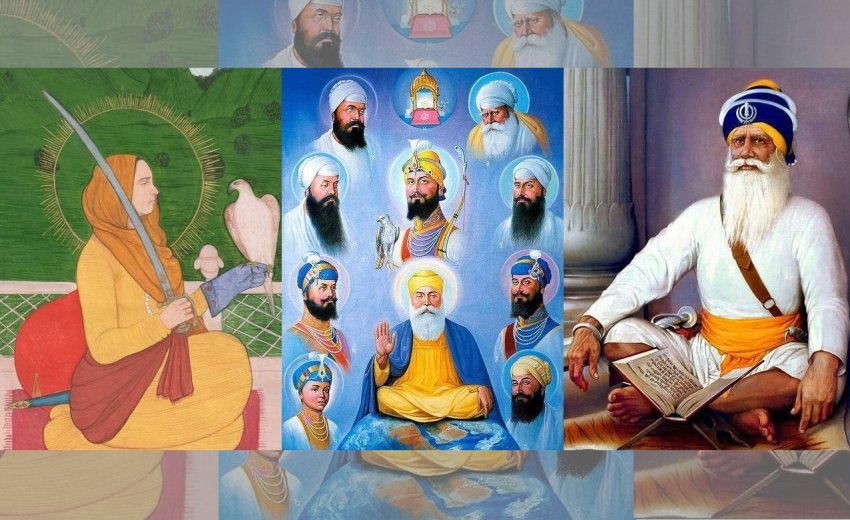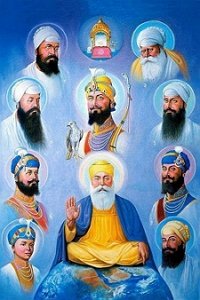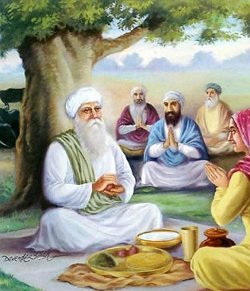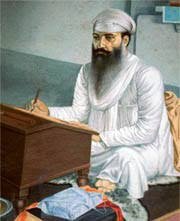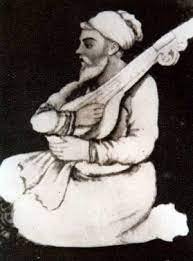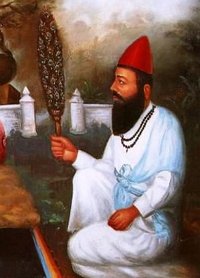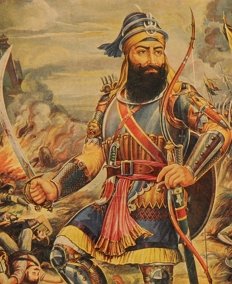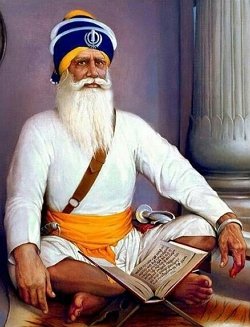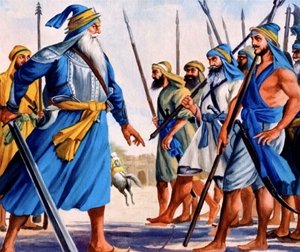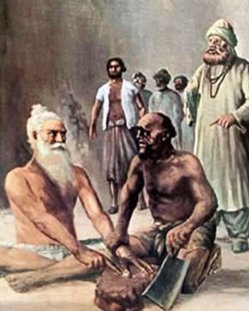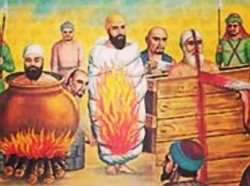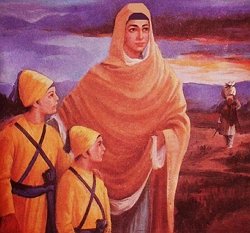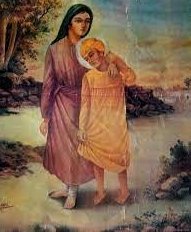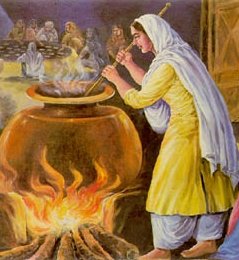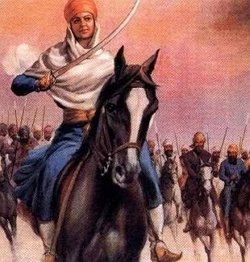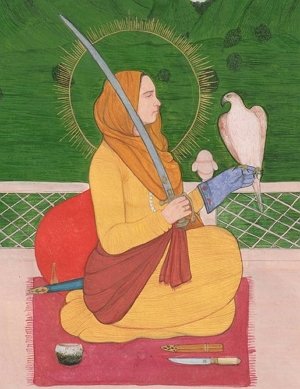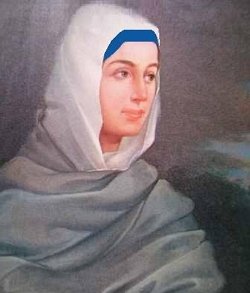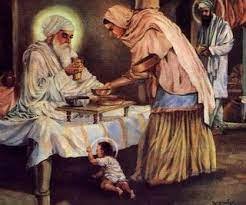Sikhism literally coincided with the birth of Baba Nanak in 1469 and it precisely took 239 years(on Jyoti jot of Guru Gobind Singh) to make a perfect in-road on this earth. Nanak got robes of wisdom (divine power) directly from GOD on his morning ablutions from the river in Sultanpur Lodhi by the end of the 15th century. Nanak effectively translated the Divine’s teachings for the welfare of mankind. After Nanak, the enlightenment (jot of wisdom) has been faithfully transferred from one guru to another which empowered them to carry forward the mission of Baba Nanak.
Participations of Spiritual and Social reformers
To accomplish of Spiritual mission and social reforms measures of Gurus, massive backup support was constantly made available to them through reformers from diversified class of people (their disciples, bhagats , literate & visionary people, warriors and even women). Baba Buddha and Bhai Gurdas (saintly religious persons)remained the most confident and dependable figures in the growth of Sikhism.THUS, THE HISTORY OF SIKHISM would be incomplete, WITHOUT DELINEATING THE CONTRIBUTION MADE BY SOME OF THE SIKH PERSONALITIES /SANTS/ RELIGIOUS PERSONS. There participation’s in the growth and development thus, need to be SIMULTANEOUSLY ACCOUNTED FOR. A brief on the wisdom of some of these luminaries and their contributions are presented as under:-
A. Sikh Sants/ Spiritual leaders
A.1 Baba Buddha Ji (1506-1631) originated from Hindu Randhawa family and named as Bhura. He was a most venerated figure in early Sikhism. He was an early disciple of Guru Nanak and became Sikh at a very young age. It is said that in his childhood, he was blessed with a long life by Baba Nanak who named him Buddha (old/aged man). Guru Nanak was amused by his mature quarries on spirituality (a cycle of life and death) at such a young age. Baba Budhha, along with Bhai Gurdas were the most confident and dependable figures in the growth of Sikhism. He performed formal coronation ceremonies of 5 Gurus who succeeded Guru Nanak. He supervised the construction of Harminder Sahib and Akal Takht. He was appointed FIRST GRANTHI by Guru Arjun Dev Ji in 1604. He also laid the foundation of Dera Baba Nanak. Guru Arjun Dev also entrusted him the job of riding and martial art training to his son Sri Guru Hargobind Rai at his young age. He died at the age of 124 in 1931. Guru Hargobind was on his bed side and felt elated by carrying his funeral pyre by reciting prayer from Adi- Granth.
A.2. Bhai Gurdas Ji (1551-1663) was an influential Sikh personality, writer, historian and preacher. He was the nephew of Guru Amar Das and first cousin of Bibi Bhani. Guru Arjun Dev ji associated him in writing Adi Granth which was completed in 1604 and placed in Harmandir Sahib and appointed Baba Buddha FIRST GRANTHI of this Gurdwara. Born in 1551 at Goindwal, Bhai Gurdas lost his parents at a very young age and thus was adopted by Guru Amar Das. He was a highly literate person and has brought out useful Punjabi literature which collectively is called as VAARAN BHAI GURDAS. Guru Hargobind ji on completion of construction of the Akal Takhat in 1609, appointed Bhai Gurdas its FIRST JATHEDAR.
A.3 Bhai Mardana (1459-1534) was the first and longtime companion of Guru Nanak ji as first in line as Guru’s noted him a Sikh. He accompanied Guru Nanak Dev on spiritual missions in India and many of the Asian countries.
He was born to a Muslim family (Mirasi couple) at Talwandi Bhoe (Nankana Sahib). His parents were very desperate as all children born to them did not survive. His mother, in despair, used to cry with the fear that this child would also not survive. She made it known to Baba Nanak. She was calling him with the name of MARJANA (MAR-JANA means that he is going to die). Nanak ji requested his mother to leave the care of her child to him. Baba Nanak re-named him MARDANA (MAR-DA-NA means Not Going to Die). Mardana also refers to a strong man.
Mardana became his childhood companion-though elder to him by 10 years. Bhai Mardana had a sweet voice and he used to sing the hymns of Kabir, Tarlochan, Ravidas, Dhanna and Bern. This art of his greatly impressed Nanak who, as a small boy, gave a stringed instrument (Rabab) to play as he sang hymns. Three of his Hymns are in Guru Granth Sahib.
Bhai Mardana permanently joined Baba Nanak at Sultanpur Lodhi, where Guruji was serving with Nawab of Sultanpur as an accountant. There they used to have Satsang morning and evening and manage langar for the entire gathering.
Bhai Mardana accompanied in all Udasi (spiritual mission) with Baba Nanak.There are many interesting stories of Mardana who had a great passion for eating. He could not tolerate hunger. He stood by Nanak ji in all thick and thin.
Finally, he fell ill and breathed his last in 1534 at Kartarpur. Guru Nanak performed all his rites at the bank of River Ravi himself. According to other Janamsakhi, Bhai Mardana died on the way back from last Udasi at Baghdad. All rituals were performed by Baba Nanak.
A.4 Bhai Bala Sandhu (1466-1544), born in Talwandi Rai Bhoi (now called Nankana Sahib in Pakistan), was a childhood friend and stated to be a lifelong companion of Bhai Mardana and Guru Nanak. According to his own Janamsakhi, he traveled with Guru Nanak and Bhai Mardana on all of their great journeys around the world including China, Mecca, and around India. He supposedly died in Khadur Sahib, in his late 70s, in 1544.
On the other side, there has been considerable discussion as regards to Bhai Bala's existence, particularly within the Sikh academicians, such as; Bhai Gurdas, who has listed all Guru Nanak's prominent disciples, does not mention the name of Bhai Bala (this may be an oversight, for he does not mention Rai Bular either). However Bhai Mani Singh's Bhagat Ratanwali, which contains essentially the same list as of by Bhai Gurdas, but with more detail, also does not mention Bhai Bala. It is also recorded amongst the literate people that the only role of Bhai Bala was to denigrate the name of Nanak and that Guru Nanak prophecies about a greater bhagat (Hundal) to come. Also, in the Bhai Bala Janamasakhi has several language inconsistencies. Thus the authenticity of his claims by and large are not beyond suspicions.
B. The Great Sikh Martyrs
B.1. Banda Singh Bahadur (1670-1716) was born in Hindu Rajput family at Rajouri (Poonch-Jammu) and named as Lachman Dev. At the very young age of 15 he left home and joined the Baragi order and became ascetic. He was given the name ‘Madho’. Later on he moved toward the south and established a monastery at Nanded at the bank of Godavari. He met Guru Gobind Singh in 1708. Guru persuaded him to join to Sikh Panth. It took several months for Guruji to convince him to accept the responsibilities to take revenge from Wazir Khan, the Governor of Sirhind and Diwan Succha Singh who mercilessly tortured and killed his two younger Sahibzadas merely of 7 and 10 years of age. Banda Bahadur finally agreed to the wishes of Guruji, got baptized by Guru Govind Singh to Khalsa Panth and was given the name as Banda Bahadur Singh, though; he changed his name to Gurbax Singh. On becoming Khalsa, he was made military Commander. He came down to Punjab where he established a Sikh State with a capital at Lohgarh. He then moved deep in Punjab. His action was to sack the Mughal provincial capital, Samana in 1709. On having established the authority in Punjab, Banda Bahadur abolished the Zamindari system and granted property rights to tillers of the land.
Battle at Chappar Chiri, Sikh soldiers killed Wazir Khan, the Governor of Sirhind, who was responsible for the Martyrdom of the younger Sahibzadas. Thereon Banda Singh Bahadur developed Lohgarh and established Sikh Raj.
During his lifetime Banda Bahadur fought 10 battles at Samana, Chapper Chiri, Sadhawara, Lohgarh, Jammu, Rohari, Jalalabad, Gurdas Nangal or siege of Gurdaspur and battle at Sirhind.
Siege in Gurdaspur Nangal: Banda after having won most of the battle and established Sikh rule was finally trapped by huge Mughal forces.
In 1715, an army under Samad Khan, the Mughal King of Delhi, drove Sikh forces in a village of Gurdas Nangal, Punjab and laid siege to the village. Sikhs strongly defended it for 8 months but finally Banda Singh Bahadur and his men were captured.
Execution at Delhi Fort: Banda Singh Bahadur was put in Iron cage and large numbers of Sikhs were chained. The Sikhs were brought to Delhi along with 2000 Sikh Heads hung on spheres and 700 cartloads of slaughtered Sikhs to terrorize the community, They were prosecuted in Delhi fort and pressurized to adopt Islam. On having refused, 100 Sikhs daily used to be brought out of the fort and murdered in public. This practice continued for a week. Even the 4 year son of Banda Singh was not spared. Banda was asked to kill his son. He flatly refused stating that Sikhs do not attack children. Instead he handed over the child to Mughals who mercilessly killed the boy.
After 3 months in prison with regular torture, on June 9th 1716, Baba Banda Singh’s eyes were pulled out and his limbs severed and skin removed and then murdered.
A War Memorial was built where the battle of Chopper Chiri was fought to glorify Sikh soldiers. The 328 feet tall FATEH BHUJ has been dedicated to Sri Banda Singh Bahadur who led the army and defeated Mughal forces. The dome of this memorial has been decorated with Khanda of Stainless Steel.
B.2 Baba Deep Singh ji (1682-1757) is revered amongst Sikhs as one of the most hallowed MARTYRS in Sikhism. Further, he was a very religious person. He is remembered for his sacrifice and devotion to the teachings of Sikh Gurus.
Born in 1682 in village Pahuwind in Amritsar District, however, in his young age, he spent considerable time with Guru Gobind Singh at Anandpur. He came again to Anandpur on Vaisakhi day in 1699 and was baptized by Guru Gobind Singh to Khalsa Panth. He continued to stay thereafter for 2 years at Anandpur where he learnt writing Punjabi and interpretation of Banis of Gurus.
He was again summoned to Talwandi Saboo in 1705 to help Bhai Mani Singh in making copies of Guru Granth Sahib for distribution to Gurdwaras. In 1709 he joined Baba Banda Bahadur where he was entrusted to lead Saheed Misl.
Worst time came, in 1757 when Emperor Ahmad Shah Durrani raided north India. Having suffered badly at the hands of Baba Deep Singh, he on his return to Lahore, ordered the DEMOLITION OF HARMANDIR SAHIB. The Darbar Sahib was blown by his son Prince Timur Shah.
Baba Deep Singh (75) took a vow to rebuild the Gurdwara ‘MAY MY HEAD FALL IN AMRITSAR’ He started his journey with a band of 500 Sikhs which swelled to 5,000 when he reached close to TarnTaran. The unit of Baba Deep Singh had to enter in clash with Afghans who were much more in numerical strength and armament. The battle was fought gallantly but the Head of Baba was severed, Baba Deep Singh continued fighting while keeping his left hand holding his head and fighting with 18 Sear (15Kg) of Khanda in his right hand. Baba continued to move towards Amritsar (covering a distance of 10 miles) and finally reached Amritsar. He breathed his last, releasing his head there. The Khanda is still preserved at a monument at the sight where he was laid to rest. People in large numbers paid homage to this great son of Khalsa Panth daily.
The place where Baba Deep Singh earned Martyrdom is known as 'Sheed Gang' and the Gurdwara in memory of Baba Deep Singh has been built.
B.3. Bhai Mani Singh ji (1670-1737) a MARTYR was a great personality in Sikh history. Though he was a childhood companion of Guru Gobind Singh, he remained attached to earlier Gurus (Guru Har Rai, Har Krishan and Guru Tegh Bahadur) and offered his selfless services to them. He took a vow OF SIKHISM WHEN GURU GOBIND SINGH CREATED KHALSA PANTH in March 1699. He was baptized in Khalsa Panth by Guru Gobind Singh by offering him Amrit.
Soon thereafter, Guru Gobind Singh sent him to Amritsar to take charge of Harminder Sahib which had been without a custodian from 1696. He became the third Granthi after Baba Buddha and Bhai Gurdas of Darbar Sahib.
He was a great scholar as well as a warrior. He fought in the battles of Bhangani and Nadaun. He accompanied Guru Gobind Singh and Mata Sahib Devan to Talwandi Sabo where he got associated with Guru Gobind Singh to up-grade Guru Granth Sahib in 1704. He also assisted Guru Gobind Singh to write ‘Dasam Granth’.
He continued to carry forward the mission of Khalsa Panth even the period after Guru Gobind Singh. In 1720 Mata Sundri came to know the deteriorating status of Harminder Sahib due to infighting. She sent Bhai Mani Singh to take control of the shrine. He effectively managed the activities at Darbar Sahib.
Execution of Bhai Mani Singh: The Governor of Lahore, Zakaria Khan, permitted the celebration of Diwali (Bandi Chor Diwas) celebration on payment of 5,000 coins. Bhai Mani Singh was confident to raise funds from collection of donations during the celebration. However, it was the evil design of the ruler to not allow Sikhs to visit during that period.
EXECUTION OF BHAI MANI SINGH: Having failed to pay the amount, Bhai Mani Singh was punished by dismemberment of his body. THE NATURE OF HIS DEATH, IN WHICH HIS DISMEMBERED JOINTS, HAS BEEN MADE A PART OF DAILY ARDAS.
B-4 Martyrdom (brutal killing) of disciples of Guru Tegh Bahadur (i) Bhai Mati Das (Vertically split by double edged sword), (ii) Bhai Sati Das (wrapped into cotton and burnt) & (iii) Bhai Dayala ji (thrown in boiling water) would continue to inflict pains to the humanity and bring shame on to the Aurangzeb rule. The head of Guru Tegh Bahadur thereafter was severed the next day at Chandni Chowk, New Delhi. To commemorate the memory of martyrdom of Guru Tegh Bahadur, there stands a Gurdwara Sis Ganj.
C. Women who enriched Sikh history
Women in uncountable numbers have immensely contributed and ably supported all through the development and growth of Sikhism and its ever-increasing credit ability, not only in India but across the globe. It is thus felt necessary to highlight the contribution of a few women who created a mark in Sikh history. Besides Mata Gujari, who consistently bore the brunt of the atrocities of Mughals on three generations of her family and thousands of innocent Sikhs, her contribution has been lamented along with the contributions of a few other brave, dedicated and pious women.
C.1 Mata Gujari (1624-1705) (whose formal name was Mata Gujar Kaur) was the wife of 9th Guru Tegh Bahadur ji; mother of the last living Sikh Guru Gobind Singh and the grandmother of four Sahibzadas. Her role in the development of Sikh faith has been very crucial. She was the wife of supreme MARTYR, mother of a great saint soldier and the grand-mother of four amazing children who attained MARTYRDOM at the age of 7,10,14 and 18 years. She helped raise the two younger Sahibzadas and took up their guardianship in their movement from Anandpur under the promise for safe passage to Delhi. She along with Sahibzadas was imprisoned at Sirhind. She attained MARTYRDOM at the age of 81 on learning that her beloved grand-children were mercilessly assassinated by the cruel hands of Nawab of Sirhind, Wazir Khan. She was the ‘IRON LADY’ who had the distinction of being a wife of 'Manavta Ki Chaddar', Guru Tegh Bahadur, gave birth to Guru Gobind Singh, raised him and subsequently his four Sahibzadas.
C.2 Bibi Nanki (1454-1518) was an elder sister of Baba Nanak, the founder of Sikhism. Nanaki is an important religious figure in Sikhism and is known as the FIRST GURSIKH. (Some writers however, have described Mardana as the first Sikh) She was the first to realize her brother’s spiritual eminence. She took all care of Baba Nanak, got him job through her husband at Modikhana of Nawab of Sultanpur, helped his newlywed wife Sulakhani to get settled, raised their children (Sri Chand and Laxmi Das) and also inspired Nanak in using music talent by using Rabab.
C.3 Bibi Bhag Bihari (Late 15 to early 16 centuries): She was one of the first women to have occupied the seat of Sikh administrative system (Manji system) of Punjab. She was appointed to the Manji (administrative unit) as its leader of Kashmir block, as Guru Amar Das felt that she is fully conversant with the doctrines of Sikh faith. She was made responsible for social, political and economic affairs of Kashmir. This responsibility she handled efficiently and effectively.
C.4 Mata Khivi (1506-1582). The soup Kitchen Master. With the growth of Sikhism and establishment of Gurdwaras, Langar became its integral part from more than 500 years ago. Mata Khivi was the wife of Guru Angad Dev had dedicated herself to the establishment of the free kitchen that provided meals to everyone. There is also a reference to Mata Khivi in Adi Granth Sahib, wherein she is described as a good person, an affectionate mother and one who provide shelter and protection to others.
C.5 Mai Bhago (late 16th to mid 17th century). The warrior bodyguard of Sri Guru Gobind Singh. Born in Punjab, Mai Bhago has learnt and mastered many skills and traits. She, other than being well versed with household affairs, had learned the art of war at an early age. Her skills of martial art came in handy when, in 1705, she led 40 soldiers, including her husband who had deserted Guru Gobind Singh at Anandpur Sahib. She fought bravely along with other units of Guru Gobind Singh's at the battle of Chamkaur. She was amongst a few survivors. Later on she became a bodyguard of Guru Gobind Singh.
C.6 Sahib (Kaur) Devan (1681-1747). The spiritual mother. She was the spiritual wife of Guru Gobind Singh with no physical relationship with Guru. She devoted herself in the service of humanity and assisted Guruji in all the affairs of community service. She would join him in serving langar, fighting battles and singing hymns. Due to her dedication to Sikh maryada, in 1699, when Guruji created Khalsa Panth, he asked her to play a central role in the ceremony in preparation of Amrit. To this day, she is considered the MOTHER OF THE KHALSA with Guru Gobind Singh its FATHER.
C.7. Bibi Nanaki Ji wife of 6th Guru Hargobind and mother of 9th Guru Tegh Bahadur was witness to the severed head of her Martyr son Guru Tegh Bahadur and accepted as a ‘WILL’ of GOD. She continues to serve the community with courage and devotion till the last.
C.8 Mata Sundri Ji (1667-1747), was a wife of Guru Gobind Singh. She after the demise of her husband Guru Gobind Singh helped to provide leadership and maintain the sanctity of Guru Granth Sahib and Harmandir Sahib. She deputed Bhai Mani Singh (1720) to take control of Harmandir Sahib, the condition of which was deteriorating owing to infighting between different fractions of the community. Mata Sundari Ji also commissioned Bhai Mani Singh to compile a volume of Dasam Granth. She served for 40 yrs for the cause of Sikhism after the demise of Guru Gobind Singh. Mata Sundri Gurudwara in Delhi is a tribute to Mata Sundari.
C.9. Bibi Bhani Ji was wife of Guru Ram Das and mother of Guru Arjun Dev. She was an inspiration during the formative period of Sikh history and symbolism, responsibility, humility and fortitude.
Compiled by Dr. Jitendra Singh Bhatia*
*+919316612588 [email protected]; [email protected]
--------------------------
Related article:
